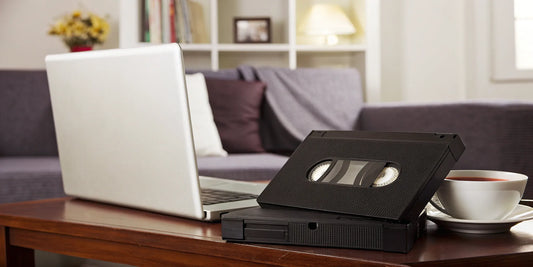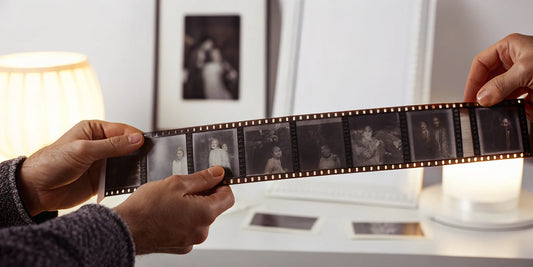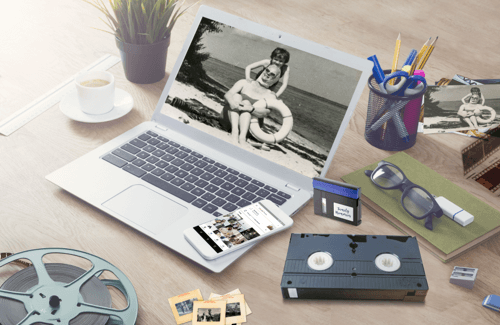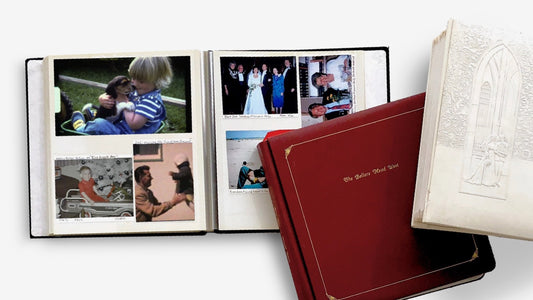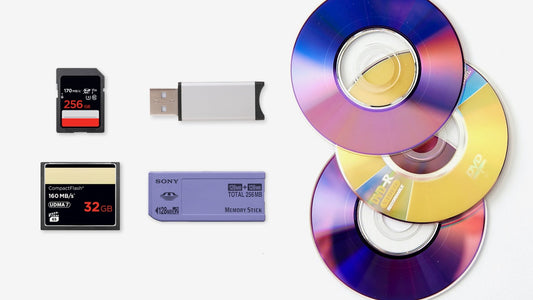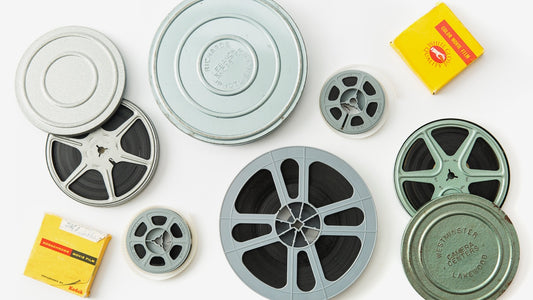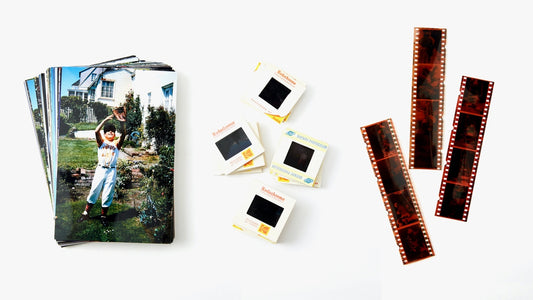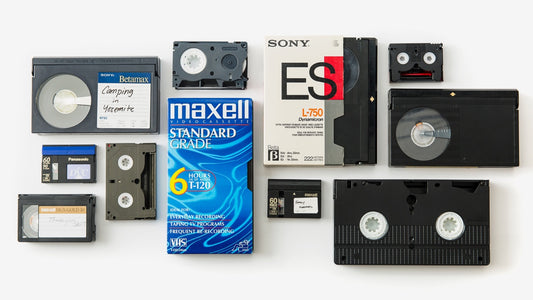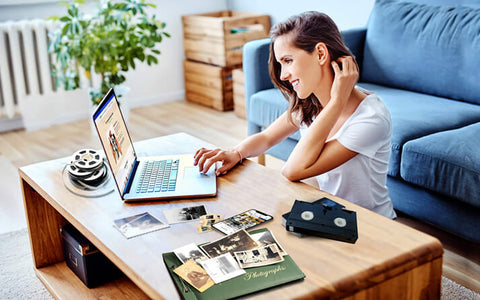Those old slides have a special charm, don't they? Each one captures a moment with a distinct vintage feel. But enjoying them is tough without a clunky projector, and sharing them is even harder. The best solution is to convert slides to digital pictures, breathing new life into your treasured images. This guide will walk you through all your options, from do-it-yourself techniques to professional scanning services. You'll learn how to preserve your family's history and finally share those memories easily, protecting your visual legacy for years to come.
Key Takeaways
- Digitize slides to safeguard memories: Protect irreplaceable family photos from damage and deterioration by creating digital copies. Digital formats offer a secure backup and simplify sharing.
- Choose the right digitization method: DIY options like slide scanners or converters offer more control, while professional services like YesVideo provide expertise and convenience. Consider your budget, technical skills, and the number of slides when deciding.
- Organize and protect your digital photos: Create a logical system for managing your digital files after conversion. Implement a robust backup strategy, like the 3-2-1 method, using cloud storage or external drives to prevent data loss.
Why It's Time to Digitize Your Slides
Remember those carousel slide projectors and the click-click-click as the trays rotated? While the memories themselves are timeless, the technology we used to capture them isn't. Digitizing your slides is more than just a trend; it's a crucial step to convert slides to digital pictures and preserve your family history. Here's why:
Those boxes of slides tucked away in the attic are vulnerable. Slides can deteriorate over time due to heat, humidity, and even just the natural aging process. Colors fade, images blur, and precious memories can be lost forever. Digitizing your slides creates a safe, permanent backup, protecting them from physical damage and ensuring those captured moments remain vivid for generations to come. YesVideo's photo transfer services can help safeguard these precious memories.
Digitizing also unlocks your memories, making them easily accessible and shareable. Imagine effortlessly viewing your slides on your computer, TV, or even your phone. No more bulky projectors or darkened rooms! You can easily share these digital images with family and friends, creating connections and sparking conversations across generations. Sharing digital photos is so much simpler than lugging around boxes of fragile slides. Plus, you can create prints, photo books, or even digital slideshows set to music, breathing new life into your cherished memories. Learn more about the benefits of digitizing slides and photos.
Finally, consider the sheer convenience. Digitizing eliminates the hassle of storing and managing physical slides. No more bulky boxes taking up precious storage space. Instead, you'll have a neatly organized digital archive, easily searchable and accessible whenever you want to relive those special moments. Professional slide scanning services can handle the entire process for you, helping you convert slides to digital pictures with high-quality results from careful handling to crisp digital images. Nostalgic Media offers professional digitization services for a variety of formats. This saves you time and effort, allowing you to focus on what truly matters – enjoying your memories.
First, Identify Your Slide Format
Before you can start the digitization process, you need to figure out what kind of slides you have. While it might seem like all slides are the same, there are actually several different formats, each with its own unique characteristics. Identifying them is the first step toward choosing the right scanning method. Don't worry if you have a mixed collection; many families do. The good news is that no matter what formats you uncover, a professional photo transfer service can handle the variety, ensuring every single memory is preserved with care and expertise, taking the guesswork out of the equation for you.
The Common 35mm Slide
If you have a box of slides from the 60s onward, there’s a very high probability that most of them are 35mm slides. This was by far the most popular and common format for consumer photography for decades. You can typically identify them by their mount, which is usually a 2-inch by 2-inch square made of cardboard or plastic. The actual film image inside the mount is rectangular. Because they are so standard, they are the easiest type to work with, whether you're using a DIY scanner or sending them to a service. Take a look at your collection—if you see those classic square mounts, you're likely dealing with 35mm slides.
Other Formats You Might Have
While 35mm slides are the most common, they are far from the only type you might find tucked away in your family's collection. Over the years, camera companies released various film formats, resulting in a diverse range of slide types. You might come across slides that look smaller, larger, or even square. Some might be housed in different materials like glass or metal. Recognizing these variations is important because they can require different scanning equipment or handling techniques. The next sections will help you identify some of these less common, but equally precious, slide formats you may have.
From 110 and 126 to Super Slides
As you sort through your slides, you might notice some that are in the standard 2x2 inch mount but have a different-sized film frame inside. Formats like 110 and 126 film produced smaller, often square, images. On the other hand, Super Slides also use a 2x2 inch mount but contain a larger square image that fills almost the entire frame. Because they share the same mount size as 35mm slides, it's easy to mistake them, so be sure to look closely at the transparent image area itself to correctly identify the format.
Medium, Large, and 3D Stereo Slides
Digging deeper into an older collection might reveal some truly unique finds. You could have medium or large format slides, which are significantly bigger than 35mm slides and often prized for their high detail. Some slides might be housed in glass or metal mounts for added protection. Perhaps the most interesting discovery would be 3D stereo slides, which consist of two nearly identical images mounted side-by-side. When viewed through a special viewer, they create a three-dimensional effect. These specialized formats often require professional equipment to digitize properly due to their unusual sizes and construction.
Should You Convert Slides Yourself or Hire a Pro?
Digitizing your slides safeguards those precious memories and makes sharing them with loved ones easy. But how do you transfer those images from those little cardboard frames to your computer? You have two main options: do-it-yourself (DIY) or a professional slide scanning service. Let's explore each one.
The Pros and Cons of Converting Slides Yourself
DIY slide conversion gives you a sense of control and can be less expensive, especially for a small number of slides. You have a few options: a dedicated slide scanner, a flatbed scanner, a digital camera, or even photographing projected slides. This flexibility lets you choose the method that best suits your budget and technical comfort level.
However, converting slides yourself is time-consuming. Imagine carefully handling each slide, positioning it correctly, and repeating the process hundreds or even thousands of times. It’s a significant time commitment. Plus, achieving professional-quality results at home takes practice, the right equipment, and technical knowledge. The results might not be as crisp or vibrant as you’d like, especially with older or damaged slides. A slide to digital image converter is often effective for most pictures, but those special memories might benefit from professional attention.
The Time Commitment: What to Realistically Expect
When you’re deciding whether to digitize slides yourself, it’s important to be realistic about the time involved. While the idea of a weekend project is appealing, the reality is that converting slides is a meticulous and lengthy process. Think about carefully handling each individual slide, placing it correctly in the scanner, and then repeating that action hundreds, or even thousands, of times. It’s a significant time commitment that requires patience and a steady hand. This process can quickly turn from a fun project into a tedious chore, especially when you have boxes full of memories waiting to be scanned.
Let's break down the numbers. Scanning a single slide can take anywhere from one to two minutes, and that doesn't even include the time spent cleaning dust off the slide, making color corrections, or fixing any other issues that pop up. If you have a collection of 500 slides, you could easily spend over 12 hours just on the scanning part. This estimate doesn't account for the initial setup, organizing your digital files afterward, or the learning curve for the software. You can find a detailed guide on how to convert slides that outlines these steps, giving you a clearer picture of the entire workflow.
Ultimately, you have to weigh the hours you'll spend against the convenience and quality of a professional service. While DIY offers control, sending your collection to experts saves you an enormous amount of time and ensures you get high-quality, vibrant digital images without the frustration. A professional photo transfer service handles the entire process for you, from careful handling to professional-grade scanning, so you can simply enjoy your beautifully preserved memories without the extensive time investment.
When to Hire a Professional Slide Conversion Service
Professional slide conversion services, like YesVideo, remove the hassle. They handle everything, from carefully handling your originals to delivering high-quality digital images. Professionals use specialized equipment and software to ensure the best color accuracy, sharpness, and resolution, revitalizing even faded or damaged slides. This expertise is especially valuable for irreplaceable memories on older film. Plus, outsourcing frees up your time.
The main consideration with a professional service is cost. While professional conversion offers convenience and quality, it’s typically more expensive than DIY. However, consider the value of your time and the peace of mind knowing your memories are handled with care and expertise. If you have many slides or quality is paramount, a professional service might be worth the investment. They often handle large quantities efficiently and reliably, minimizing the risk of errors that can happen with DIY methods.
Top-Rated Scanners for Converting Slides at Home
If you're ready to digitize your slides yourself, you have a few good options. This section breaks down the best DIY methods and products, so you can preserve those precious memories.
Dedicated Slide and Film Scanners
For dedicated slide digitization, slide scanners offer a great balance of quality and convenience. They come in a variety of price points to fit any budget. A quick search on Amazon reveals options ranging from budget-friendly models under $20 to higher-end scanners over $200. Look for features like adjustable resolution (DPI), batch scanning capabilities, and software compatibility with your computer. The popular Kodak Slide N SCAN is a reliable choice for beginners, with thousands of positive reviews. Don't forget to check for used or refurbished options to potentially save even more.
Easy-to-Use Slide to Digital Converters
If scanners feel a bit too technical, slide to digital image converters offer a simpler approach. These devices typically work by taking a photo of each slide and saving it as a digital file. While they might not offer the same resolution as dedicated scanners, they're incredibly user-friendly, perfect for quickly digitizing a smaller collection. Think of them as a happy medium between a full-fledged scanner and a professional conversion service. You'll maintain more control over the process than with professional services, without the technical learning curve of a scanner. Many converters also offer additional features like built-in memory and LCD screens for previewing images.
Using a Mobile App to Scan Slides
The solution to digitizing your slides might already be in your pocket. Mobile apps like SlideScan use your phone’s camera to capture and convert your slides into digital photos. The process is simple: just hold a slide up to a backlight (like a laptop screen showing a white page) and use the app to scan it. This is a fantastic option if you only have a handful of slides or want to quickly see what’s on them without buying extra equipment. The convenience is hard to beat—you can digitize, save, and share a memory in just a few minutes, right from your phone.
Alternatives to Scanners: Slide Duplicators
If you're a photography enthusiast with a DSLR or mirrorless camera, a slide duplicator is a great alternative. This device is a tube that attaches to your camera lens and has a slot at the end to hold a slide. It lets you take a high-resolution photograph of your slide, creating a digital copy. While this method requires more technical setup than a simple converter, it can produce excellent quality if you have a good camera and lens. It’s a cost-effective way to convert slides to digital without buying a standalone scanner, putting your existing camera gear to good use.
Reviewing the Top Slide Conversion Services
If DIY isn’t for you, several companies specialize in digitizing slides. Here’s a rundown of some popular services:
YesVideo
YesVideo specializes in converting a wide range of formats, including videotapes and film reels, but they also handle photo formats, including slides. Their dedicated slide scanning service ensures your memories are preserved in high-quality digital files. As a trusted name in the industry, YesVideo prioritizes careful handling and quality conversions.
Nostalgic Media
Nostalgic Media offers slide scanning services, producing 3200 DPI JPEG images suitable for both viewing and printing. Their typical turnaround time is 7–10 business days, and they offer a 100% satisfaction guarantee.
Legacybox
Legacybox digitizes a variety of formats, including slides, photos, and home movies. They send you a box for your items, digitize them, and return your originals along with digital copies on a thumb drive, cloud storage, or DVDs. Standard processing takes 10–12 weeks, but they also offer expedited options.
ScanMyPhotos
ScanMyPhotos is another option for digitizing your slides. Check their website for the most up-to-date details on pricing, turnaround times, and available formats.
DigMyPics
DigMyPics also offers slide scanning services. Visit their website for current service information, including pricing and estimated turnaround times.
Walgreens Photo
Walgreens Photo offers digitization services for a variety of formats, including slides. They provide a convenient option for those who prefer a local drop-off and pick-up process.
CVS Photo
While CVS Photo primarily focuses on film processing and photo printing, they also handle slide processing and can create prints from your slides. This can be a useful service if you want physical prints in addition to digital files, or if you need your slides developed before digitization.
How to Choose the Right Slide Conversion Service
Picking the right slide conversion service takes a little research. Use these guidelines to find a company that will treat your memories with the care they deserve.
Check for High-Resolution Scans
Image quality and resolution are paramount when digitizing slides. Look for services that create high-resolution images suitable for both viewing and printing. A higher DPI (dots per inch) means more detail and clarity, allowing for enlargements without pixelation. Nostalgic Media, for example, offers 3,200 DPI JPEG images. Don't hesitate to ask potential services about their scanning process and the final resolution they provide. Clear communication upfront will ensure you're happy with the results.
Understanding the Price Tag
Pricing structures vary across slide conversion services. Some companies offer per-slide pricing, while others offer bulk discounts or package deals. Nostalgic Media's pricing starts at 42¢ per slide (with a $30 minimum order). Legacybox offers a starter kit (up to two items) for $33.98. Compare pricing models and consider any special offers that align with the number of slides you need converted. Getting the best value for your money is important, but remember to balance cost with quality.
Watch for Additional Fees
When you're comparing services, the per-slide price is just the starting point. It’s important to look for any additional fees that might apply. For example, many services offer custom organization, allowing you to group your digital photos into specific folders like "Vacation 1990" or "Family Christmas." This is a fantastic feature for keeping your memories tidy, but it often comes at an extra cost. Some companies charge a fee for each custom folder you request. Before you commit, read the fine print or the FAQ page to understand what’s included and what will be an add-on, so there are no surprises on your final bill.
Factoring in Shipping Costs
Don’t forget to account for shipping when calculating your total cost. You’ll need to send your precious slides to the company, and they’ll need to send them back to you along with your new digital copies. Some services offer free return shipping for larger orders but may charge a flat fee for smaller ones, so it's essential to factor this into your budget. At YesVideo, we simplify this by sending you a crush-proof box with a pre-paid shipping label, so you can send your memories with confidence. Always choose a service that offers trackable, secure shipping to protect your irreplaceable originals during transit.
How Quickly Will You Get Your Pictures Back?
How quickly do you need your digital images? Turnaround times depend on the service and its current workload. Nostalgic Media advertises an average turnaround of 7–10 business days. Legacybox estimates 10–12 weeks for standard processing, with expedited options available. Factor in your timeline when making your decision. If you need your images quickly, prioritize services with faster turnaround times.
What Digital Formats Do They Offer?
Ensure the service you choose can handle your specific slide formats. Older or less common formats can sometimes present compatibility issues. If you have unique or older slides, confirm with the service that they have the necessary equipment and expertise. Smooth Photo Scanning discusses common challenges in slide conversion. Knowing your slide types beforehand will help you avoid potential problems.
Digital Delivery Methods: Cloud, USB, or DVD
Once your slides are scanned, you'll decide how you want to receive the digital files. Most services offer a few choices: cloud storage, a USB drive, or a DVD. Cloud access offers incredible convenience, letting you view and share your photos from anywhere, almost instantly. Services like YesVideo provide a private online account where your memories are securely stored and ready to share. A USB drive provides a great physical backup, especially for large collections, giving you a tangible copy that plugs into nearly any modern device. DVDs are also an option, but they are becoming less common as many new computers don't have disc drives. I recommend choosing a service that offers a combination, giving you both the immediate access of the cloud and a physical backup for long-term peace of mind.
Safe Handling and Security of Your Slides
The security and handling of your irreplaceable slides should be a top priority. Choose a service that prioritizes the safety of your originals. Look for services that provide updates throughout the process and guarantee the return of your original slides along with the digital copies. Nostalgic Media performs all work in-house, ensuring your slides never leave their secure location. Legacybox also guarantees the return of your originals. A reputable service will treat your memories with respect and ensure their safekeeping. Don't be afraid to ask questions about their handling procedures – peace of mind is priceless.
Look for Satisfaction Guarantees
A satisfaction guarantee is more than just a refund policy; it’s a company’s promise to treat your memories with the respect they deserve. When you’re handing over irreplaceable slides, you need assurance that the final digital images will meet your expectations. Reputable services understand this and will often guarantee their work, offering to re-scan your media for free or provide a refund if you're not completely happy. This commitment shows that the company is confident in its equipment, process, and technicians. It provides you with crucial peace of mind, knowing that your investment in preserving your family’s history is protected and that the service is dedicated to delivering high-quality results you’ll cherish for years.
How Does Slide Conversion Actually Work?
Converting slides to digital photos involves a few key steps. Whether you choose DIY or professional conversion, understanding the process helps ensure your precious memories are preserved.
Step 1: How to Prepare Your Slides for Scanning
Before you begin the slide conversion process, organize and assess your slides. This crucial first step streamlines the digitization process, whether you're doing it yourself or using a service. Sort your slides, remove any dust or debris, and group them logically. This might be by date, event, or subject matter. Identify any particularly fragile slides that may need extra care. This preparation will make the scanning process smoother and more efficient.
Cleaning Your Slides Safely
Dust, fingerprints, and grime can easily get scanned along with your image, becoming a permanent part of your digital memory. To get the cleanest scan, you’ll want to gently clean your slides first. Always start by wearing soft, anti-static gloves to protect the slides from fingerprints and oils. For loose dust and lint, a can of compressed air held at a safe distance or a gentle wipe with an anti-static cloth is usually all you need. If you encounter more stubborn grime or even mold, be very cautious. Using liquid cleaners can permanently damage the slide’s delicate emulsion. For slides that are in rough shape, it’s often best to let an expert handle the restoration. A professional photo transfer service has the right tools and experience to clean fragile slides without causing harm.
Organizing and Labeling for Easy Sorting
A little organization now will save you a massive headache later. Before you scan, group your slides in a way that makes sense to you. You might sort them by year, by event (like "Grand Canyon Trip 1988"), or by the person who took them. If your slides are already in carousels, you’re one step ahead! Once sorted, place them in archival-safe plastic pages that fit into a three-ring binder. These archival pages are designed to protect your slides without causing chemical damage over time. Label each page clearly. This creates a physical map that will make naming and organizing your digital files so much easier once the conversion is complete.
Step 2: Scanning and Digitizing
You have several options for digitizing your slides. If you’re comfortable with a hands-on approach, you can convert slides to digital yourself. This typically involves using a scanner—either a dedicated slide scanner or a flatbed scanner with a transparency adapter. Alternatively, you can photograph your slides with a digital camera or capture images projected from a slide projector. Each method has its own set of pros and cons regarding image quality, cost, and time investment. Another option is to use a slide scanning service. Professional services handle the entire process, from scanning to image enhancement. This saves you time and ensures high-quality results, especially for large collections or delicate slides. Services like YesVideo specialize in this type of conversion, offering expertise and quality control.
Choosing the Right Scanning Resolution
When you digitize your slides, resolution is key to getting a great result. Think of it as the level of detail captured in the digital image. For standard 35mm slides, a scan of about 10 megapixels (MP) is a great target. This gives you enough detail to create a beautiful print up to about 13x9 inches. While it might seem like higher is always better, that’s not necessarily the case. An extremely high-resolution scan can sometimes pick up the natural grain of the film itself, which might not be the look you’re going for. Professional services have already figured out the ideal balance, ensuring your digital photos are sharp and clear without unwanted texture. This is one of the main benefits when you transfer photos with experts.
Using Technology to Remove Scratches (Digital ICE)
Over the years, slides can collect dust, fingerprints, and tiny scratches. Luckily, technology offers a fantastic solution. Many high-end scanners and professional services use a feature called Digital ICE (Image Correction and Enhancement). This technology uses an infrared light pass during the scan to detect physical defects on the slide's surface. It can then intelligently remove dust and scratches from the final image without softening the important details. It’s a game-changer for restoring old slides to their former glory. For slides with more significant damage, manual photo editing might still be needed, which is another area where professional technicians can make a huge difference in the final quality of your memories.
Step 3: Enhancing and Checking Image Quality
Regardless of your chosen method, quality control is essential. If you’re scanning slides yourself, you’ll likely need to edit the images. This might include adjusting brightness, contrast, and color balance, as well as removing dust spots or scratches. Be aware that manual conversion can be time-consuming and may lead to errors, especially with large quantities of slides. Professional slide conversion services often include image enhancement as part of their process. They have the expertise and equipment to handle color correction, dust removal, and other adjustments, ensuring the best possible results. They also understand the nuances of handling delicate film and can take precautions to prevent damage. Consider the potential for errors and the value of professional expertise when deciding on your approach. For many, the time saved and the quality gained outweigh the cost of a professional service.
How Much Does It Cost to Convert Slides to Digital Pictures?
When it comes to digitizing your slides, figuring out your budget is key. Let's break down the costs of doing it yourself versus hiring a professional service, so you can make the best choice for your needs and wallet.
DIY slide conversion involves some upfront equipment costs. A dedicated slide scanner can be a bit of an investment, but it delivers high-quality images. If you're looking for a more budget-friendly option, you can use a flatbed scanner or even your digital camera. Keep in mind though, while these methods are easier on your bank account initially, they might require more of your time and effort to get great results. You might also need to invest in photo editing software to touch up your images afterward.
Professional slide scanning services offer a convenient, hands-off approach. YesVideo offers competitive pricing and specializes in handling precious memories with care. This route eliminates the need for you to buy any equipment or spend hours hunched over a scanner. Services like this can be especially helpful when dealing with delicate or damaged slides.
Think about your time commitment, too. DIY might save you money upfront, but it can be a time-consuming process, especially if you have hundreds of slides. Professional services take care of everything for you, freeing up your time. Plus, they often have the expertise and equipment to ensure consistent quality, something that can be tricky to achieve on your own, especially with faded or damaged slides. Ultimately, the best approach depends on your budget, how much time you have, and the quality you're aiming for.
Tips for a Flawless Slide to Digital Conversion
A few simple steps can dramatically improve the quality of your digital images. Whether you're tackling the project yourself or hiring a professional service, these tips will help you get the best possible results.
First, clean your slides. Dust, fingerprints, and other debris can significantly impact the quality of your scans. Gently remove any particles with a soft, lint-free cloth or compressed air before scanning.
For those scanning at home, the right equipment is key. A dedicated slide scanner will produce far better results than a standard flatbed scanner. Pay close attention to the resolution and aim for at least 2400 DPI to capture the details in your slides. Proper lighting is also crucial. Use even, diffused light to minimize shadows and glare.
If DIY isn't a good fit, consider a professional slide scanning service. Professionals possess the expertise and equipment to create top-notch digital images from your slides. YesVideo's slide scanning services offer meticulous attention to detail, ensuring your memories are beautifully preserved.
You've Digitized Your Slides. Now What?
After converting your slides to digital images, managing and protecting those precious memories is essential. This involves organizing your files and implementing a robust backup and storage strategy.
Simple Ways to Organize Your Digital Photos
A little organization goes a long way. Once your slides are digital, you have countless ways to share and enjoy them. Think about how you want to access these photos in the future. Creating a clear, logical system now will save you time and frustration later.
Consider organizing your photos chronologically, by event, or even by family member. You can use folder structures on your computer or photo management software to categorize and tag your images. Descriptive file names also make searching for specific photos much easier. For example, instead of "IMG_1234.jpg," use a name like "FamilyVacation2010_BeachDay.jpg." Photo management software can streamline this process.
If you’re digitizing a large collection, you might consider a hybrid approach to save money. Convert most of your images using a slide to digital image converter, and reserve professional services for your most treasured slides.
How to Safely Back Up and Store Your Photos
Don't risk losing your precious memories. Digital photos are vulnerable to hard drive crashes, accidental deletions, and other unforeseen events. Backing up your files is crucial for protecting your digital treasures.
The 3-2-1 backup strategy is a reliable method: keep three copies of your photos on two different media types, with one copy stored offsite. This could mean saving your photos on your computer's hard drive, an external hard drive, and a cloud storage service. Cloud storage offers an added layer of protection against physical damage or loss. Many services, like Google Photos or iCloud, offer automatic backups, making the process seamless. You can also explore dedicated photo storage solutions designed specifically for archiving images. Reliable slide scanning services often offer advice on best practices for backing up and storing your digital files, so don't hesitate to ask for recommendations.
Your Slide Conversion Questions, Answered
Q: Can I convert slides to digital photos myself?
A: Absolutely! You can convert slides using a slide scanner or a slide-to-digital image converter. A slide scanner creates high-resolution digital images directly from your slides. A slide converter typically photographs your slides, which may result in lower-resolution images. Consider your needs and technical comfort level when deciding if DIY slide conversion is the right path for you.
Q: What are the benefits of using a professional slide conversion service?
A: Professional services like YesVideo offer expertise and specialized equipment to convert slides to digital pictures, ensuring high-quality scans and preserving your memories with precision and care. They handle various slide formats and sizes, saving you time and effort. Professional services provide a hassle-free experience with reliable results, though they are often more expensive than DIY methods. For a truly hands-off approach, consider a full-service option that includes organizing and enhancing your digital images.
Q: How much does slide conversion cost?
A: The cost depends on whether you choose DIY or professional services. DIY involves the upfront cost of a scanner or converter, ranging from around $80 to several hundred dollars. Professional services typically charge per slide or per image, with prices varying based on resolution and any additional services. Our cost comparison section offers a detailed breakdown to help you understand the potential expenses.
Q: What are some common challenges in slide conversion?
A: Digitizing slides can present some hurdles. Older slide formats might not be compatible with current equipment. Dust, scratches, and color fading can impact image quality. Manually converting many slides is time-consuming and can introduce errors. Properly preparing your slides can minimize issues. If you’re concerned about these challenges, a professional service might be a better fit, as they have the expertise and tools to handle them effectively.
Q: What should I look for when choosing a slide conversion service?
A: When selecting a service, consider image quality and resolution, pricing, turnaround time, format compatibility, and security. Look for services that use high-resolution scanners and offer a variety of output formats. Read reviews and compare pricing to find a service that aligns with your needs and budget. Ensure the service has secure handling procedures to protect your memories during the conversion process. It's also wise to check their customer service policies. Common customer complaints can include long wait times and poor communication, so choose a service known for customer satisfaction.
Related Articles
- Digitize Slides to Images: Top Services & DIY Guide – YesVideo
- How to Transfer Slides to Digital: DIY & Pro Guide – YesVideo
- Convert Photo Slides to Digital: DIY & Pro Guide – YesVideo
- VCR to Digital: 2023 Guide to Converting Tapes – YesVideo
- Best VHS Video to Digital Converters: Top Picks – YesVideo
Frequently Asked Questions
Q: What's the best way to organize my slides before digitizing them?
A: Before you start scanning, sort your slides into meaningful groups. This could be by date, event, family member, or any other category that makes sense to you. Removing any dust or debris with a soft cloth beforehand will also improve the final image quality. This initial organization will make the digitization process, whether DIY or professional, much smoother and help you manage your digital files later.
Q: My slides are really old and faded. Can they still be digitized?
A: Yes, even faded or damaged slides can be digitized. While DIY methods might have limitations, professional services often use specialized equipment and software to enhance older slides, improving color and sharpness. They can often recover images that seem lost to time, breathing new life into those precious memories. If you have particularly fragile or damaged slides, it's always best to consult with a professional service about the best approach.
Q: What's the difference between a slide scanner and a slide-to-digital image converter?
A: A slide scanner creates a direct digital image of your slide, typically at a higher resolution. A slide-to-digital image converter essentially takes a photograph of your slide. Converters are generally more affordable and user-friendly but may not offer the same level of image quality as a dedicated scanner. The best choice depends on your budget, technical skills, and the quality you want for your digital images.
Q: How can I ensure my digital photos are safe after I convert them?
A: Digital photos are susceptible to loss, so backing them up is crucial. The 3-2-1 backup strategy is a good rule of thumb: keep three copies of your photos on two different storage types, with one copy stored offsite. This could involve using your computer's hard drive, an external hard drive, and cloud storage. Cloud storage offers additional protection against physical damage or loss and often includes automatic backup features.
Q: What if I have a huge collection of slides? Is there a cost-effective way to digitize them?
A: For large collections, consider a hybrid approach. You could use a more affordable slide-to-digital image converter for the bulk of your slides and reserve professional services for your most important or damaged slides. This allows you to balance cost and quality. Many services offer bulk discounts, so be sure to inquire about those when comparing pricing. You can also prioritize digitizing the most important slides first, giving you time to evaluate different methods and services.



